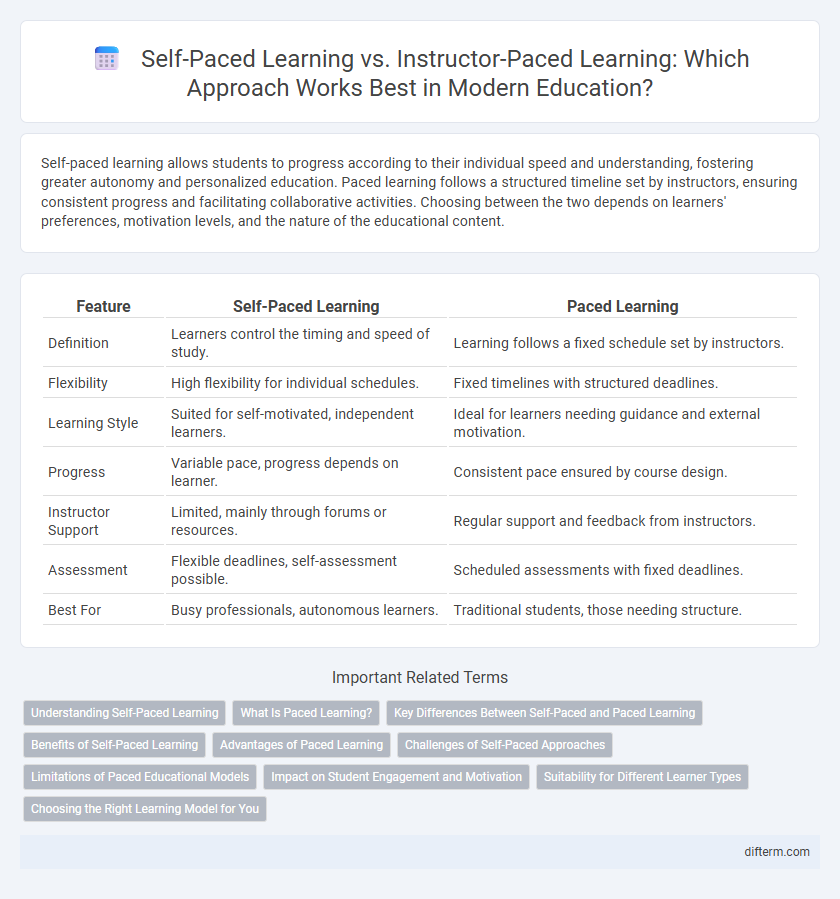Self-paced learning allows students to progress according to their individual speed and understanding, fostering greater autonomy and personalized education. Paced learning follows a structured timeline set by instructors, ensuring consistent progress and facilitating collaborative activities. Choosing between the two depends on learners' preferences, motivation levels, and the nature of the educational content.
Table of Comparison
| Feature | Self-Paced Learning | Paced Learning |
|---|---|---|
| Definition | Learners control the timing and speed of study. | Learning follows a fixed schedule set by instructors. |
| Flexibility | High flexibility for individual schedules. | Fixed timelines with structured deadlines. |
| Learning Style | Suited for self-motivated, independent learners. | Ideal for learners needing guidance and external motivation. |
| Progress | Variable pace, progress depends on learner. | Consistent pace ensured by course design. |
| Instructor Support | Limited, mainly through forums or resources. | Regular support and feedback from instructors. |
| Assessment | Flexible deadlines, self-assessment possible. | Scheduled assessments with fixed deadlines. |
| Best For | Busy professionals, autonomous learners. | Traditional students, those needing structure. |
Understanding Self-Paced Learning
Self-paced learning allows learners to progress through educational material at their own speed, accommodating individual learning styles and schedules, which fosters deeper comprehension and retention. This method leverages digital platforms and resources, enabling access to diverse content anytime, enhancing learner autonomy and motivation. Understanding self-paced learning is crucial for educators seeking to design flexible curricula that support personalized education and improve student outcomes.
What Is Paced Learning?
Paced learning refers to an educational approach where instructors or curricula set a fixed schedule and uniform deadlines for all students, ensuring consistent progression through the material. This method promotes structured learning environments, facilitating time management and regular assessment points for measuring student progress. Paced learning is particularly effective in courses requiring sequential skill acquisition and cohort-based interaction.
Key Differences Between Self-Paced and Paced Learning
Self-paced learning allows students to progress through course material at their own speed, providing flexibility and personalized control over study time, while paced learning follows a fixed schedule with predetermined deadlines and structured timelines. Key differences include the autonomy in managing learning pace, individual responsibility for time management in self-paced learning, versus instructor-led progress tracking and peer interactions in paced settings. Self-paced learning suits learners needing flexibility and customization, whereas paced learning benefits those requiring guidance, regular feedback, and social engagement for motivation.
Benefits of Self-Paced Learning
Self-paced learning offers personalized flexibility, allowing students to progress according to their individual understanding and schedule, which enhances retention and reduces stress. This approach supports diverse learning styles and paces, fostering deeper engagement and improved mastery of subjects. Moreover, self-paced learning promotes autonomy and intrinsic motivation, crucial factors for long-term educational success.
Advantages of Paced Learning
Paced learning structures the curriculum with fixed schedules, enhancing time management and consistent progress through material. It fosters regular interaction with instructors and peers, boosting motivation and accountability in students. This method reduces procrastination and helps maintain a steady learning rhythm, leading to improved retention and academic performance.
Challenges of Self-Paced Approaches
Self-paced learning often presents challenges such as a lack of structured guidance, which can lead to procrastination and inconsistent progress among students. Many learners struggle with time management and motivation without external accountability, impacting the overall effectiveness of self-paced courses. Additionally, the absence of immediate feedback from instructors can hinder concept retention and ultimately affect learning outcomes.
Limitations of Paced Educational Models
Paced educational models often limit learner autonomy by enforcing a fixed schedule that disregards individual learning speeds and comprehension levels. This rigidity can result in increased stress and reduced retention as students may struggle to keep up or become disengaged if the pace is too fast or slow. The lack of flexibility in paced learning environments restricts personalized learning experiences, hindering optimal knowledge acquisition and skill development.
Impact on Student Engagement and Motivation
Self-paced learning enhances student engagement by allowing learners to control their study speed, resulting in increased motivation and personalized mastery of concepts. Paced learning provides structured timelines that promote discipline and consistent progress, which can benefit students who thrive on external accountability. Balancing flexibility with clear deadlines optimizes motivation and sustains long-term academic commitment.
Suitability for Different Learner Types
Self-paced learning offers flexibility ideal for independent, motivated learners who prefer customizing their study schedules, enhancing comprehension through personalized pacing. In contrast, paced learning suits students who benefit from structured timelines, consistent deadlines, and guided progression, fostering discipline and accountability. Understanding these distinctions supports tailoring educational approaches to diverse learner needs, improving engagement and academic outcomes.
Choosing the Right Learning Model for You
Self-paced learning allows students to progress through material at their own speed, fostering personalized understanding and flexibility, which is ideal for motivated learners with varying schedules. Paced learning follows a structured timeline set by educators, promoting discipline and consistent progress, suitable for those who benefit from guided instruction and peer interaction. Selecting the right learning model depends on individual learning preferences, goals, and time management skills to maximize educational outcomes.
Self-paced learning vs paced learning Infographic

 difterm.com
difterm.com